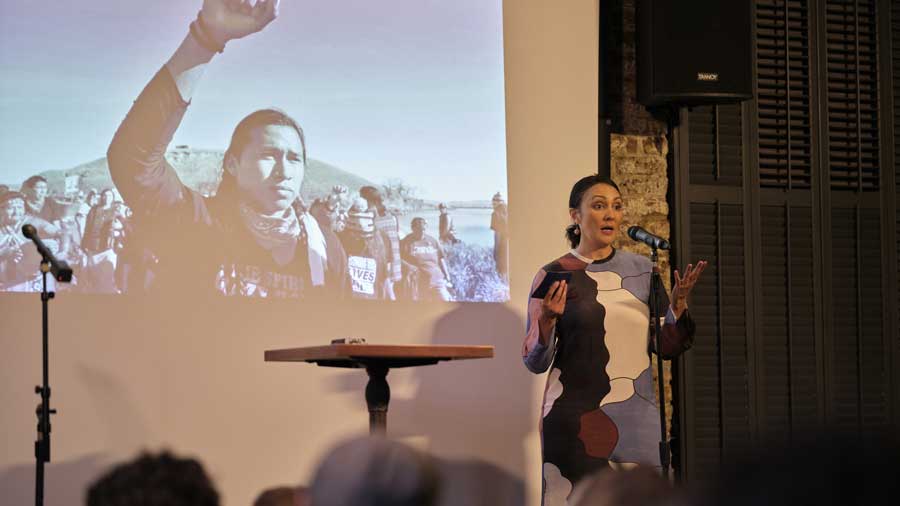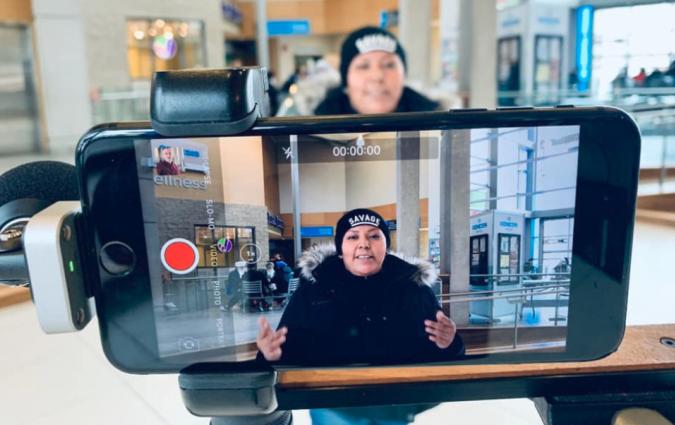In this piece
Five pressures facing Indigenous journalists (and what to do about it)

ABC's Indigenous Affairs Editor Bridget Brennan presenting her findings in London. Photo: Andrew Bailey
In this piece
1. Pitching the story: "Imagine having to plead your own humanity." | 2. Moral injury: "You are watching people die in slow motion from neglect." | 3. The cultural load: "I’m going to have to answer for that." | 4. Translation exhaustion: "Now I have to make sure your work is culturally competent." | 5. Racist abuse: "Start the morning trawling through racist emails." | What to do about itIn the past five years alone, Indigenous journalists have uncovered multiple allegations of human rights abuses in settler colonial countries. These stories have exposed allegations of police brutality, the disappearances and murders of Aboriginal women, land theft, deaths in custody, racist media coverage and failures to repatriate human remains.
But amidst all the power and promise inherent in the growth of Indigenous affairs beats around the world, there are unseen pressures that – if not dealt with systematically – threaten to derail the progress made.
We can start to alleviate the risk of burnout and disillusionment if we talk more openly about the factors that can make this job so challenging.
During my fellowship at the Reuters Institute, I conducted six in-depth interviews with Indigenous journalists from five countries to ask why so many talented First Nations journalists consider quitting, despite loving the work that they do.
Five key themes emerged. This list is not exhaustive, but it serves as a starting point. Some of these will be applicable to other journalists from marginalised communities, too.
1. Pitching the story: "Imagine having to plead your own humanity."
When I asked Indigenous journalists to reflect on key stressors associated with their beat, the first challenge they mentioned was not the emotional toll of telling traumatic stories or racist abuse from audiences; it was the challenge of getting their stories greenlit in the newsroom.
Many Indigenous reporters I spoke to said they have pitched stories predominantly to non-Indigenous commissioning editors throughout their career. While all recounted working with excellent non-Indigenous executive producers and editors, to be blunt, there are still some who do not understand or acknowledge their own biases and hold stereotypical views about our people.
Multiple Indigenous journalists recall examples where their original story ideas were put in the “too-hard” basket by a commissioning editor who couldn’t or wouldn’t take the time to understand the value of a proposed story.
Tristan Ahtone is Editor at Large at Grist. He previously served as Editor-in-Chief at the Texas Observer and Indigenous affairs editor at High Country News. He said Indigenous reporters are spending too much time explaining and unpacking a story to editors who can’t see its worth. “I think probably 75% of the time it’s, ‘We don’t understand this, so you shouldn’t do that’. We’re tending to spend a tonne of our time trying to explain why a story is important.”
Graham Lee Brewer is an investigative journalist at NBC News and citizen of the Cherokee Nation. He recounts how a newspaper editor at a previous organisation rejected an investigation into corruption allegations relating to a tribal government. “His response was, ‘Well, you know, that’s a really tricky area and it’s kind of a quagmire, I don’t know that we really want to try to step into that world.’ And I was like, ‘Just so I’m understanding you correctly, what you’re saying to me is that you think it’s too difficult to cover this government, so you don’t want to do it?’”
Convincing senior producers and editors that Indigenous content matters has been a “massive battle” for decades, said Anishinaabe (Ojibway) journalist Duncan McCue, who has been a television and radio reporter at CBC for 25 years. “There was a narrative frame that was kind of acceptable of what made Indigenous news. And it was always tragedy or protest… otherwise, Indigenous stories just weren’t considered. It’s become easier in the last five years because of analytics; we can show that our digital articles and our podcasts are top of the charts in lots of instances. They are ratings winners, if you want to be that crude about it.”
Jamie Tahana is the former Māori news editor at the public broadcaster Radio New Zealand. He is Ngāti Pikiao, Ngāti Makino, Te Arawa from the Bay of Plenty on the North Island of New Zealand. He said he felt some stories reported by Māori journalists were not taken seriously. “The fact I had to fight so much meant I kept doing less of our stories just because we kept having to argue.
“There’s a block between us making our stuff and our audience. And that block is the non-Māori editorial.”
2. Moral injury: "You are watching people die in slow motion from neglect."
Celebrated Wiradjuri journalist and author Stan Grant wrote in Talking to my country about the invisible scars we bear as Indigenous people. “We know this history, my people. This is a living thing. We touch it and we wear it. It is carried deep within us, mental wounds that cannot heal. It is so close we can touch it.”
Having an intimate understanding and knowledge of what our interview subjects have experienced can mean Indigenous journalists feel the full emotional weight of the stories. Whether it is investigating missing and murdered women or the horrors of residential schools and the Stolen Generations, this work “can be really hard on your heart and your soul,” said CBC's McCue.
The impact of colonisation, assimilation policies, and the dispossession of our lands continues to have a profound and severe legacy for Indigenous societies. Our crises are ongoing, and our sources are often victims of generations of injustice.
Torres Strait Islander journalist Isabella Higgins experienced this when she investigated injustices facing her own Aboriginal and Torres Strait Islander people. “You never leave a story at the end of the day. There’s no transaction between journalists and [source]. You look at the people you’re interviewing, and you think ‘This could be my mum, this could be my sister, this could be me’.”
It’s worth highlighting work by Professor Anthony Feinstein to define ‘moral injury’, which happens to journalists “when you feel that somehow you’ve done something that might have compromised your own moral code of ethics, your own moral compass.” It can come from witnessing other people’s behaviour too, he said.
Higgins suggests newsrooms should start to acknowledge that First Nations correspondents are required to do a highly complex “cross-cultural” job that requires its own supportive structure and psychological support. “When I went to Ukraine, there was an understanding that you came back with images in your head that you would remember forever. But I don’t think anyone understands that in some Indigenous communities, you are watching people die in slow motion and die from neglect. And that is so upsetting and heart-breaking.”
3. The cultural load: "I’m going to have to answer for that."
Multiple Indigenous affairs reporters said that culturally insensitive, ill thought-out and, frankly, racist coverage by their own or other news outlets can be an immense source of stress. Stories that are carried out in an irresponsible, rushed, or damaging way can cause irreparable harm to relationships with First Nations communities, and Indigenous affairs reporters have to be the ones to remedy the damage.
Cherokee investigative reporter Brewer said it is imperative that our colleagues understand the impact on Indigenous reporters when “harmful” stories go to air. “If I ever come calling in that community, I’m going to have to answer for that.”
Māori journalist Tahana calls it “intercepting”. It’s the common practice of Indigenous journalists who often rush to fix a mistake made by colleagues before a story is aired, or being first port of call from irate community members when it’s too late. “When you find out who a program may or may not be going to [for a comment] or an angle they may be missing, that's another cultural load thing for our team. Often we wear the criticism … because we've got the relations and contacts.”
Yle Sámi journalist Xia Torikka said missteps can happen when Indigenous colleagues aren’t privy to an upcoming program or report that has not had oversight from Indigenous affairs specialists. “One example is one of the biggest TV talk shows in Finland: they did this big TV clip about conflict in the Sámi community. We didn’t even know that they were doing it, and it caused a big scandal almost. [Since then] they have been asking for advice. What I think they should do is include us. Because I don’t think it’s enough that [non-Indigenous journalists] just consult us about Sámi. We should be the ones there – to be writing, directing, producing it.”
Despite many examples of reporting that marginalises our people, Indigenous reporters I spoke to felt coverage by mainstream outlets has improved in the past five years. McCue said there had been a “marked change” in the “quantity” and the “quality” of Indigenous affairs reporting, especially in the past three years in Canada. But, he added, there are still lots of missteps. “I could spend five minutes on Google News and find you some examples of headlines that are awkward and poorly written.” It’s why he is passionate about high-quality training for non-Indigenous reporters and why he wrote a textbook that’s an in-depth guide to Indigenous affairs reporting.
4. Translation exhaustion: "Now I have to make sure your work is culturally competent."
Native, Aboriginal and Māori journalists I spoke to were encouraged that a new generation of non-Indigenous journalists are often producing respectful reporting on Indigenous affairs. In an effort to ensure their story is accurate and sensitive, many of those colleagues will ask us to check a script or a feature story, or even give detailed advice on a complex investigation.
Requests for help can come after hours, while you’re already on deadline, or while you’re in the field on assignment. Sometimes there is a request for cultural context, access to our contacts or tribes, or even a ‘mini’ history lesson. Typically, Indigenous reporters said this is stressful and adds to their workloads.
Here’s how Brewer described it: “Let’s say I’m working on a story and someone from another department within my news organisation says: ‘Hey, would you look over my script?’ It’s like, OK, well now I have to take time out of my day to make sure that your work is culturally competent and I’m not getting paid extra for that, I might be on deadline and I’m taking time out of my important work to do that. And also, it’s not my fault that your department has not prioritised hiring Native people.”
Veteran Indigenous journalist Francine Compton said it can be powerful to help to lift someone else’s work, but the problem is that the work is often not acknowledged or remunerated. “It’s actually empowering to be able to [make a positive change]. But at the same time, they weren’t rewarding [that work] in a way that was affecting my paycheque.”
Nueta Hidatsa Sahnish College president Dr. Twyla Baker describes Indigenous people’s additional work of providing explanation and historical context as "translation exhaustion". Indigenous reporters said this underscores the importance of having distinct First Nations units with multiple staff, because being the only one in your newsroom with expertise on these issues can be hugely draining.
5. Racist abuse: "Start the morning trawling through racist emails."
Arguably the most dispiriting and destructive threat facing Indigenous reporters, anchors and media professionals is the racist abuse we are subjected to.
At various points in my career, I’ve been the target of racist abuse, commentary and feedback via my email and direct messages on social media. So have far too many of my First Nations colleagues. It’s worse for Indigenous women in the media, who can be subject to both racist and sexist abuse.
Researchers in Australia found “industry complacency and internal discrimination were impacting on organisations’ ability to properly protect diverse media workers”.
When Tahana and another Māori colleague decided to move on from their positions at RNZ, he said they both reflected that “it’s kind of nice to not start the morning trawling through racist emails.” He believes many media organisations are ill-equipped to support journalists who are harassed.
“We always say to ourselves, it’s sort of fuel for the fire, right? Just let it stoke what we’re doing because we must be doing something right. But [you shouldn’t] have to reframe it that way. I don’t think there is enough organisational support for that stuff. There’s internal fights and then there is also the lack of realisation about what we’re fighting elsewhere as well.”
Compton, associate director of the Native American Journalists Association, said news organisations urgently need to come to grips with the problem of abuse being levelled at First Nations journalists online. “I’ve seen Indigenous journalists who are telling stories for the community – award-winning, important, life-changing stories. But when it comes to them needing to face this online abuse and racism… when I’m seeing those reporters needing to take time off, then that’s really where I’d like to see more international awareness and campaigns to help stop that from happening.”
McCue said it continues to be one of the most corrosive stress points for First Nations reporters, and it’s not only coming from the audience. “There’s also the issue of cultural safety within our newsrooms.”
Indigenous affairs journalist Higgins reflected on how stressful and isolating this can be for young First Nations people in newsrooms. “It was really depressing to hear people you worked with and respected basically revealing the unconscious bias or casual racism that they held inside of them and were comfortable to display because they didn’t even realise it.”
What to do about it
How can we begin to accelerate change in newsrooms for Indigenous affairs journalists?
My interviewees called for more dedicated and well-resourced Indigenous affairs units led by Indigenous journalists and editors who deeply understand the issues. These teams need adequate funding and resources, equivalent to other respected bureaus. They also need editorial autonomy for meaningful story selection.
Respectful collaboration with Indigenous reporters should be encouraged, avoiding assumptions about their automatic availability for advice.
Embracing solutions-focused journalism will diversify the narrative and breaks stereotypes.
To ensure cultural competency across the newsroom, non-Indigenous staff should receive training – possibly through a two-tier system with the basics for all reporters and advanced training for those who want to take on reporting Indigenous stories.
Training initiatives must be genuine and ongoing, fostering real change rather than mere tokenism.
Attention should be given to the emotional wellbeing of Indigenous reporters, promoting trauma-informed reporting and allowing breaks between intense investigations.
Additionally, fostering global knowledge exchange by inviting Indigenous journalists and mental health professionals to share insights can significantly enrich newsrooms' understanding of Indigenous issues.
I hope this project (full paper available as PDF here) will be useful to newsrooms that are finally beginning to invest in more Indigenous-run reporter units, rounds, beats and desks to cover First Nations communities. However, this crucial investment must be accompanied by improved structures, hiring practices and mentorship of the next generation of Indigenous journalists.



